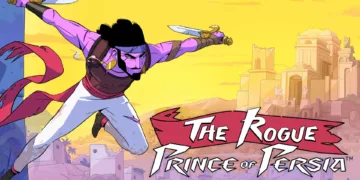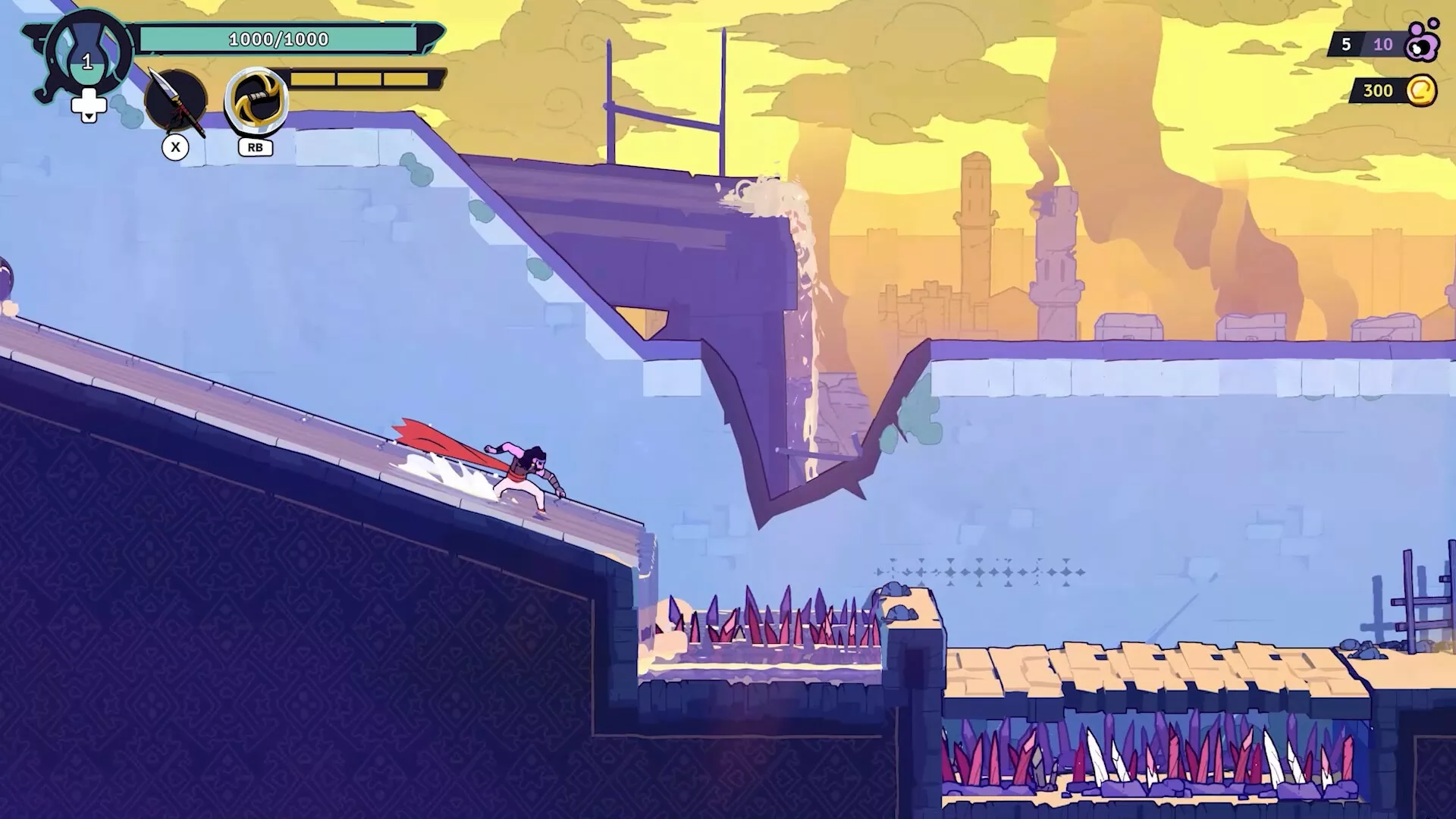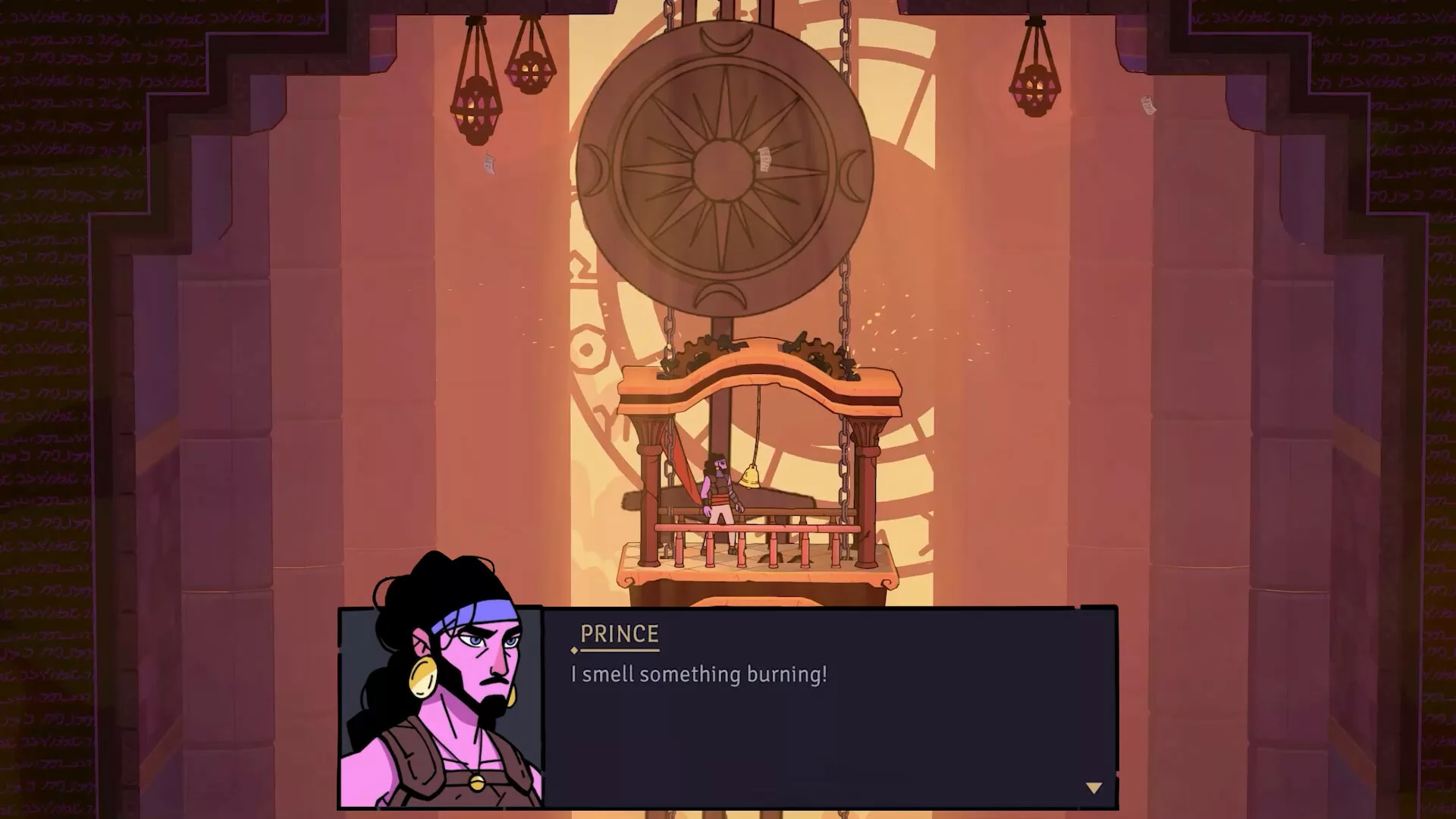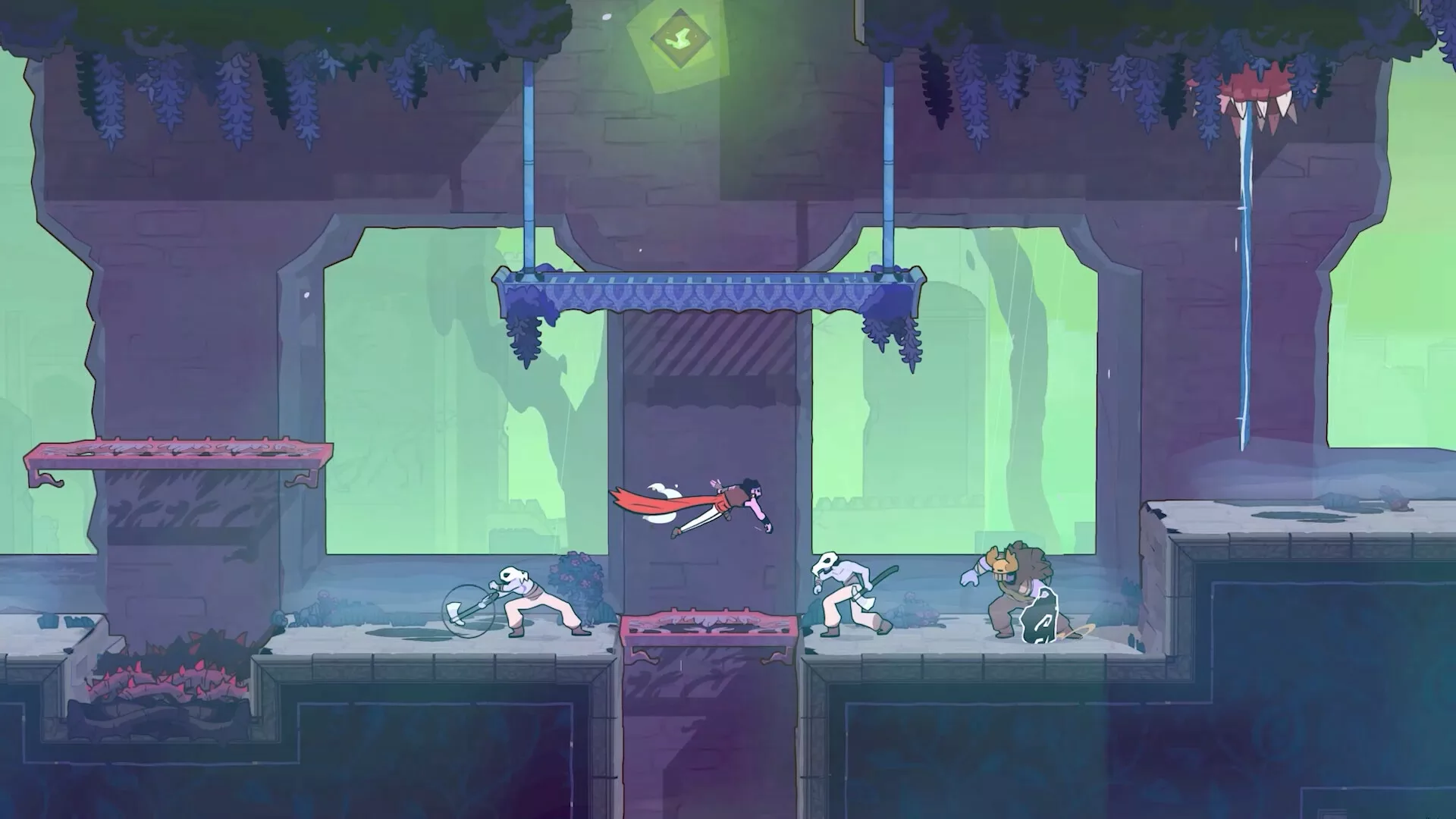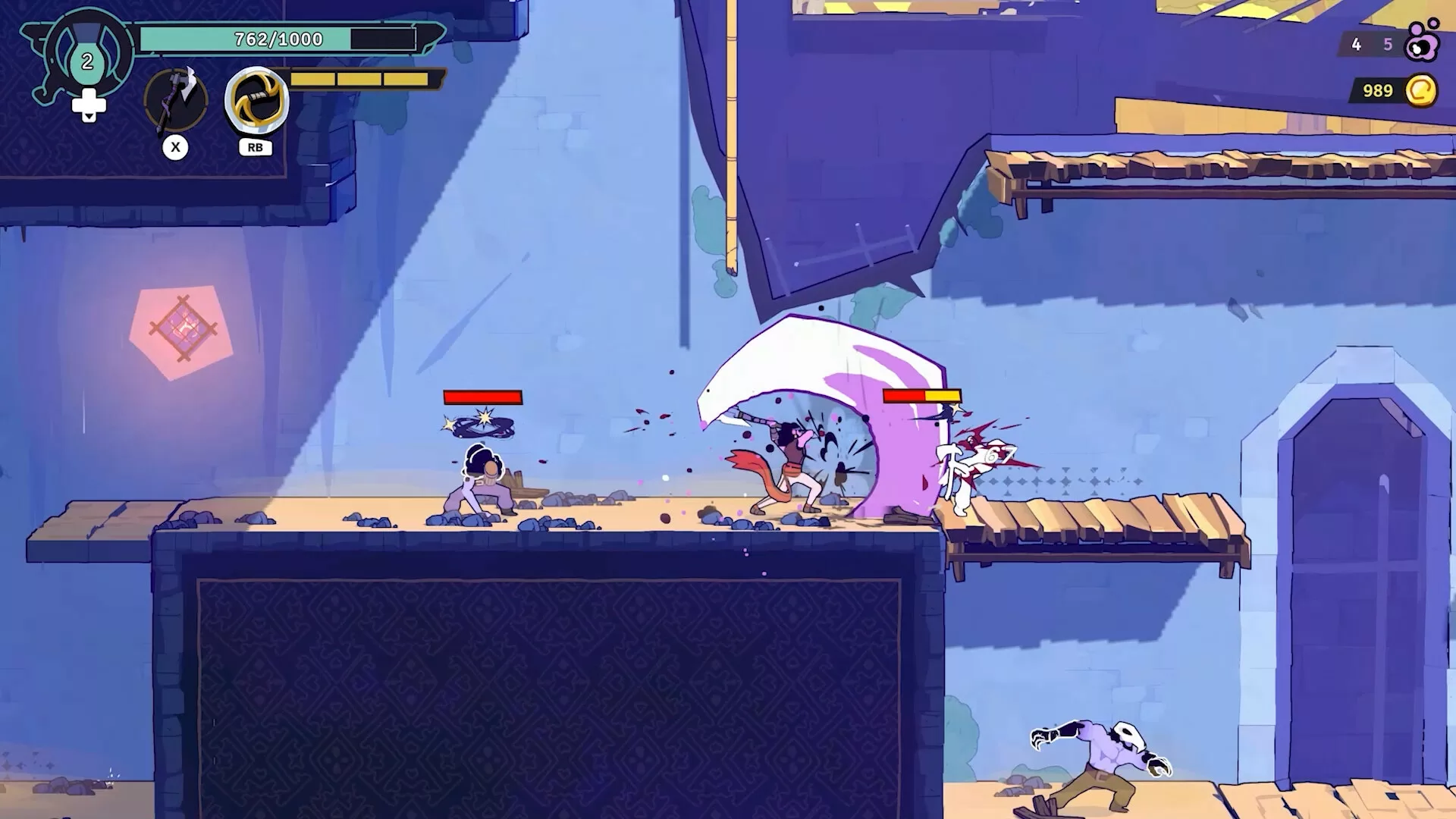In the lush oasis of the prince’s kingdom, a cunning fight is underway. Our hero awakens to find his people besieged by the invading Hun army, who tower over the land with dark magic and a force of steel. But this prince has courage in his heart and an ace up his sleeve—a magical bolo that allows him to turn back time if he falls in battle.
Developed by Evil Empire, the talented team behind Dead Cells, The Rogue Prince of Persia takes the familiar roguelike formula and imbues it with flair befitting of the source material. Players control the acrobatic Prince as he makes daring escapes across each colorful region, navigating tricky platforming with wall-running prowess. Combat brings a flurry of melee maneuvers and ranged trickery, from spears and swords to trap-setting techniques.
Along the way, players will encounter treacherous terrain and formidable foes, from charging brutes to magic-wielding shamans. But new weapons and upgrades can be unlocked between runs, strengthening the prince for future face-offs. An investigation system also provides narrative threads to follow, uncovering the mysteries of this war-torn land. With procedurally-generated layouts, each new journey offers fresh challenges through beloved Prince of Persia gameplay reimagined with roguelike risk and reward.
Moving Through The World of Rogue Prince
Climbing and combat define the experience in The Rogue Prince of Persia. Players take control of the Prince as he navigates treacherous terrain and battles the invading Huns. His sublime mobility allows him to traverse environments in ways other games only hint at.
Wall-running is the signature move, letting the prince dash horizontally along any vertical surface. It opens up a whole new dimension of movement, whether scaling precarious cliffsides or evading assaults in tight quarters. Combined with a toolkit of jumps and aerial attacks, players can express their parkour abilities to extreme degrees. Rogue Prince challenges push these skills, with extra rewards waiting at the end for those agile enough to reach them.
Keeping foes at bay requires the deft use of weapons and special techniques. A variety of melee arms lend different rhythms to clashes, from quick daggers to impactful swords. Ranged tools leave opportunities for area control or sneak attacks. Well-placed kicks provide breathing room, either stunning opponents or launching them off the edge. For additional strengths, medals can be equipped, their passive bonuses transforming basic actions in inventive ways.
Procedurally generated levels summon unique perils each time. Distinct biomes like lush forests or sandy deserts set the stage for platforming puzzles and combat encounters. Shrewd monsters apply magic enhancements, forming diverse enemy compositions. Resource management adds strategy as supplies replenish between regions. With new pathways unlocked through continued play, new strategies and abilities can be employed in the quest for ultimate victory.
Persia’s Rogue Prince Pursues Revenge
The Prince awakens with a heavy heart, his city conquered by invading Huns wielding sinister magic. Though death has lost its hold on him through an ancient bola granting its bearer a second chance, vengeance will not come easy. Each foray into the hostile wilderness comes with risks, all in a desperate bid to grow stronger.
Procedurally generated landscapes pose ever-changing threats, their dangers heightened by the prince’s solitary struggle. Yet with each defeat comes insight; clues gleaned from fallen foes point the way towards allies and the enemies controlling them. As the prince pushes further into peril, embracing each death as an opportunity to learn, new friends begin joining his cause.
A brother taken captive is the first casualty motivating the prince’s mission. Through runs defined by dynamic combat and fluid acrobatics, he gradually uncovers the shadowy forces driving the Hun war machine. Side characters reveal their own stakes, expanding a narrative informed by the prince’s discoveries. Despite setbacks, bonds form that carry genuine weight across successive campaigns.
As the story progression breathes life into the Prince and those whose fates intertwine with his, motivation shifts from vengeance alone. Coming to understand all those impacted by the invasion gives purpose to each life lost in the pursuit of toppling oppression. Only by facing hardship as a united front against tyranny can Persia know peace once more.
Visuals and Sound
The Rogue Prince of Persia grabs you from the start with its striking visual presentation. Clean black outlines give form to colorful characters that pop against lushly detailed backgrounds. Levels come to life with ornate tile work with just enough design to transport players to another land while maintaining clarity. Clever use of lighting brings scenes to life without distraction. It allows for focus on fluid acrobatic action without visual noise getting in the way.
This simplistic yet vibrant style is no mere aesthetic choice. It proves to be a practical one too, with gameplay maintaining silky smoothness even during the most intense moments. Benchmark testing showed barely a stutter on high-powered machines. Accessibility remains a priority, it seems, with this title poised to run refreshingly well on a variety of hardware when the official release arrives.
Beautifully, the experience goes beyond sight. An eclectic soundtrack fills each nook and cranny with atmosphere. Lilting strings whisk players to mosques and madrasas while electronic flourishes and kinetic combat. Distinct music plays for each location, culturally grounded yet modernized for engaged focus. Sound effects provide punch, from the prince’s aeriated maneuvers to the meaty impact of weaponry.
Together, the visual and audio realms pull viewers straight to the setting. Though stripped of excess, their marriage plunges headlong into adventure. Technical feats mean spectacle stands side by side with pleasure rather than hampering it. The result elevates this rogue-like tale to operatic heights, keeping immersion seamless as the story and gameplay continuously unfold.
The Prince’s Quest
While The Rogue Prince of Persia delivers an immensely satisfying flow of parkour and platforming, players may face repetitive challenges within its early levels of content. Wall-running through each of the six initial biomes becomes second nature, and without variation, completing runs can feel like checking items off a list. Battles are entertaining through fluid combat, yet the handful of unlockable weapons lack diversity.
Progress lies not in what happens during runs, but between them. Earning spiritual essence from fallen enemies funds upgrades in a safe hub outside the haze of battle. New trinkets and mods flesh out playstyles, while hard-earned funds purchase stronger weapons and tools. Slowly, experimentally crafted builds emerge with bonuses triggered by well-timed swings or hits. Players tap into an Aladdin’s cave of potential, where synergy sparks surprises.
However, not all feel included in this quest. Difficulty selection and customization are missing, barring some from experiencing parkour bliss. The prince’s story welcomingly embraces all, yet the game in its beginnings risks losing part of its audience because of a lack of choice. Accessibility remains a work in progress.
Despite constraints, hope remains. Like the prince refusing to succumb to invading forces, developers show tenacity through responsive patching. Early steps, while not reaching all lands, show a willingness to expand borders and work until each person can feel the thrill of mastering moves through high walls and across perilous gaps. In time, as growth continues, many more may find joy and reward in joining the prince’s engaging adventure against imposing odds.
The prince’s story is one of perseverance and opening locked doors. In this initial telling, some portals remain shut, but the spirit and mechanics already show glimpses of great potential. With a commitment to include more travelers in the future, this game of reflexes may become one that resonates across worlds.
Comparisons to Dead Cells
Prince of Persia: The Rogue strikes a familiar chord yet brings new strings to the roguelike melody. Its DNA shares traits with the genre giant Dead Cells, but a distinct parental legacy is apparent too.
Traversing The Rogue’s procedurally pieced worlds feel cut from the same cloth as trudging Celldwell’s islands and fortresses; runs consist of platforming and punching through pixelated panoramas in search of strength-granting stuff. Weapon wheels similarly rotate between melee motifs and ranged requirements, from daggers and maces to slingshots and shurikens. Foes also follow familiar faction formulas, dividing between armored aggro artists and projectile-pounding pals.
Yet the rogue’s ancestry shines through too. Its protagonist punctuates proceedings with acrobatic agility absent from Dead Cells’ brutes, wall-clinging and flip-flopping foes with balletic bravado. Levels likewise leverage layouts for limber-lunging, challenging climbs over competitors’ combat-centric coliseums.
Where Dead Cells thrived on item influx, The Rogue remains rawer – runs currently contain less unlocks with unlocking impact diminished. But its ownership of mobility marries momentum to mechanics in a manner few matches. And where progression paths diverge, common combatocore crochet quality content that core roguelike fans will rate highly regardless of enrichments eventually emerging. Both bombastic beginnings bode beautifully for further finetuning fostering longterm fandom.
Persia’s Prince Shows Promise
While still in early access, The Rogue Prince of Persia shows glimpses of greatness in its stylish combat and fluid parkour. Development studio Evil Empire skillfully incorporates the saga’s acrobatic heritage into rogue-like gameplay.
Wielding a magical bola, players control the prince as he races through procedurally-generated levels. Scaling walls with abandon, players soar over hazards in a fluid dance. Foes fall to melee weapons and well-timed kicks, though combat variety remains limited. Deliriously fun movement helps offset this for now.
Between runs, currency unlocks new abilities and tools. Yet progression feels stunted compared to genre giants like Hades. With expansion, character and plot could bloom into something richly engaging. As it stands, brief expeditions leave players wanting more.
By virtue of its strong foundation, this early version nonetheless satisfies genre fans. With scope to implement community ideas, continued evolution bodes well. As histories have shown, Persia’s royalty shines brightest when given room to develop. Under adept guidance, this youthful adventure could achieve majesty in time. For anyone seeking fresh takes on beloved classics, The Rogue Prince of Persia shows early signs of greatness to come. Though not fully formed, its soul shows through—wise to keep an eye on this rising star.
The Review
The Rogue Prince of Persia
Stripped to its basics but fueled by fluidity and fanservice, The Rogue Prince of Persia proves a competent exercise in environmental parkour and roguelike runs. While its narratives remain nascent and progression initially light, core systems show sparks of brilliance ready to catch fire. The Evil Empire establishes a foundation on which greatness could be built.
PROS
- Tight, fluid parkour and movement mechanics
- A distinct visual style that pays homage to source material
- Satisfying the core rogue-like loop and combat
- There is potential for significant growth as more content is added.
CONS
- Thin narrative and progression elements at the early access launch
- Limited weapon variety and build options
- Low biome and level variation
- Low difficulty and challenge for skilled rogue-like players
